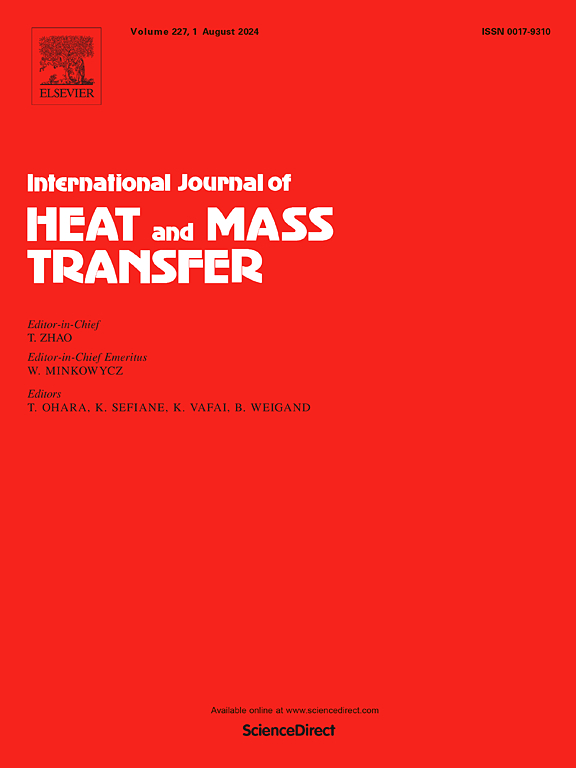一种具有梯度毛细管芯和更大膨胀面积的新型蒸汽室
IF 5
2区 工程技术
Q1 ENGINEERING, MECHANICAL
International Journal of Heat and Mass Transfer
Pub Date : 2025-04-09
DOI:10.1016/j.ijheatmasstransfer.2025.127021
引用次数: 0
摘要
随着芯片集成度和性能的提高,功耗也在增长,这使得热管理变得至关重要。虽然蒸汽室提供了高效的传热、均匀的热分布和简单的结构,但沟槽和网格设计的毛细力不足以满足更高的冷却要求,因此需要更高效的技术。本研究提出了一种纵向梯度烧结毛细管铜基蒸汽室,克服了传统槽式和网状结构的局限性,增强了液体的输送,加快了内部循环,改善了蒸发区的液体供应。实验装置采用的工质为去离子水,使设计适用于较高的热流密度和功率条件。通过液冷板对蒸汽室进行了热表征,系统研究了不同倾角和冷却剂温度对其性能的影响。实验结果表明,倾斜角度对性能影响不大,垂直操作时热阻仅比水平操作时增加0.007 K/W。此外,提高冷却液温度可以显著改善传热性能,与20℃相比,40℃时的热阻降低了26.1%。此外,实验结果表明,在高达1200 W的功率输入下,蒸汽室保持稳定的功能,对应的热流密度为240 W/cm²,此时的热阻为0.047K/W,表明其具有管理极高功率芯片的潜力。本文章由计算机程序翻译,如有差异,请以英文原文为准。
A novel vapor chamber with gradient capillary wick and larger expansion area
As chip integration and performance increased, power consumption grew, making thermal management critical. While vapor chambers offered efficient heat transfer, uniform heat distribution, and simple structures, the capillary force of grooved and mesh designs were insufficient to meet higher cooling demands, highlighting the need for more efficient technologies. This study presents a longitudinally gradient sintered capillary copper-based vapor chamber to overcome the limitations of traditional grooved and mesh structures, enhancing liquid transport and accelerating the internal cycle for improved liquid supply to the evaporation zone. The working fluid employed in the experimental setup consisted of deionized water, making the design suitable for higher heat flux and power conditions. Thermal characterization of the vapor chamber was conducted through a liquid cooling plate, and the effects of different inclination angles and coolant temperatures on performance were systematically studied. Experimental results showed that inclination angle had little effect on performance, with thermal resistance increasing by only 0.007 K/W when operated vertically compared to horizontally. Additionally, raising the coolant temperature significantly improved heat transfer performance, reducing thermal resistance by 26.1 % at 40 °C compared to 20 °C. Furthermore, Experimental results demonstrated that the vapor chamber maintained stable functionality under power inputs reaching up to 1200 W. corresponding to a heat flux of 240 W/cm², at this time, the thermal resistance was 0.047K/W, indicating its potential for managing extremely high-power chips.
求助全文
通过发布文献求助,成功后即可免费获取论文全文。
去求助
来源期刊
CiteScore
10.30
自引率
13.50%
发文量
1319
审稿时长
41 days
期刊介绍:
International Journal of Heat and Mass Transfer is the vehicle for the exchange of basic ideas in heat and mass transfer between research workers and engineers throughout the world. It focuses on both analytical and experimental research, with an emphasis on contributions which increase the basic understanding of transfer processes and their application to engineering problems.
Topics include:
-New methods of measuring and/or correlating transport-property data
-Energy engineering
-Environmental applications of heat and/or mass transfer

 求助内容:
求助内容: 应助结果提醒方式:
应助结果提醒方式:


